The Map That Came To Life: A Memento from Childhood
Ask a dozen adults to each name a treasured item from childhood and the chances are you’ll hear a dozen different answers. Every child finds wonder in something that is unique to them. For me, that treasured item is a picture story book titled The Map That Came To Life, originally published in 1948 by the Oxford University Press.
This richly illustrated and somewhat romanticised view of the post-war British countryside tells the story of two children, John and Joanna, who, whilst holidaying at their Uncle and Aunt’s farm, ask permission to visit a country fair in the nearby town of Dumbleford.
“Of course you may go,” said Uncle George. “It’s only a few miles from Two Tree Farm. I suggest you start out early and walk there. And you must take your lunch with you. It is a very interesting walk. I’ll show you.”
He opened a drawer under the bookcase and brought out a map – an Ordnance Survey map. 1 He opened it and laid it on the carpet. The children knelt beside it while Uncle George pointed out first Two Tree Farm, then the little town of Dumbleford, and finally the common nearby – Coldblow Common – where the fair was to be held. He showed them the roads, the lanes and the field and woodland paths they would walk along to get to the fairground.
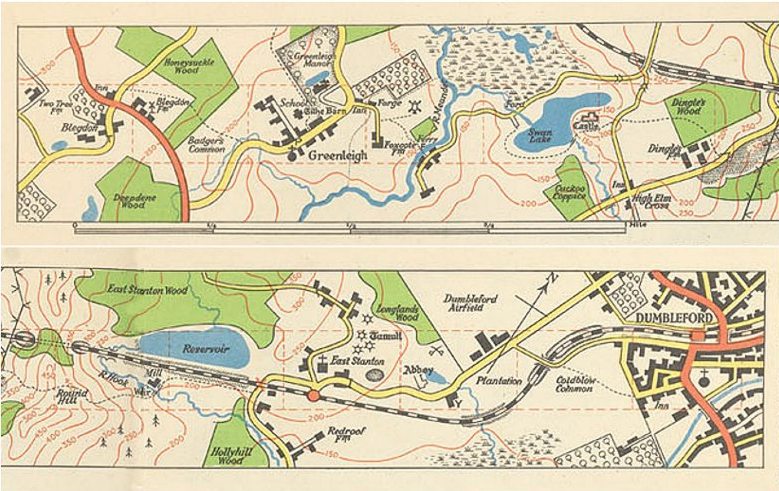
With Uncle George’s help, John and Joanna learn how to relate the map’s legend to features in the surrounding landscape. Then, with the appropriately named ‘Rover’ the farm dog at their side, they plan their grand day out.
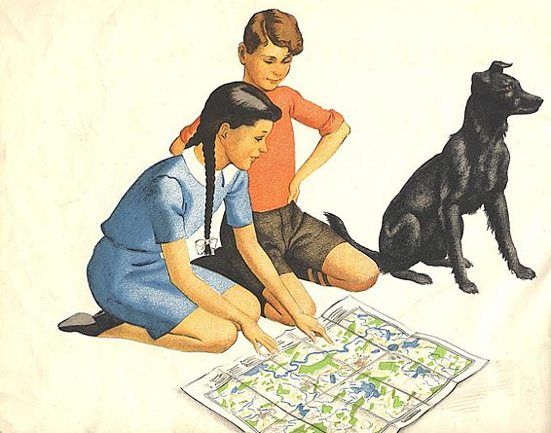
We’ll rejoin John, Joanna and the appropriately named dog once they’ve finalised their route, but first let’s meet the two friends who created The Map That Came To Life.
The Names Behind the Book
Henry ‘Harry’ James Deverson (1908-1972) was born in Bromley, Kent (South-east England). Whilst publicly available information about his youth is scant, it is known that he was raised in Sidcup, Kent and had a younger sister named Mona. Henry developed an early interest in writing and photography, which would later become the basis for a career in photojournalism. He’s best remembered as the art editor for Picture Post, 2 published by Hulton Press 3 from 1938 to 1957. 1938 was also the year that he married; a union that produced two daughters, one of whom is the (now retired) journalist and writer, Jane Deverson – co-author of the 1965 book Generation X. 4
The professional yet amiable ‘Dev’, as he was known to colleagues, had a knack for talent spotting. He mentored many an up-and-coming photographer, 5 including the young Lord Snowdon 6 – socialite, portraitist and one-time brother-in-law to Queen Elizabeth II.
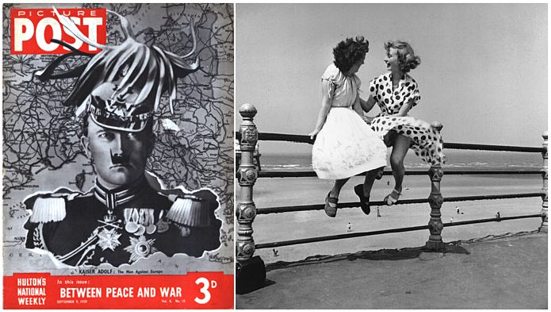
Deverson’s illustrator for The Map That Came To Life was Ronald George Lampitt (1906-1988). 7 Born and raised in Worcestershire, the naturally talented Ronald taught himself to paint and draw, later earning a place at the prestigious Slade School of Fine Art in London. However, his father refused to let him attend, advising his son to instead ‘get a proper job’. Ignoring that advice, Lampitt focused on making a living as a landscape painter and illustrator – and by the 1930s he was a successful commercial artist, designing some of the most memorable railway poster art of that decade.
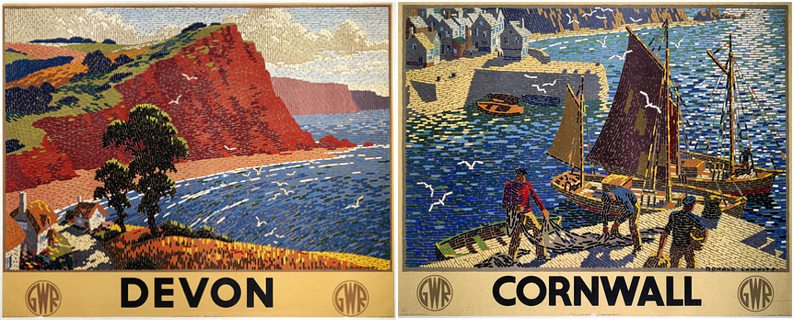
Deverson and Lampitt’s paths crossed at some point during this time, probably when Lampitt was working with the Artists Partners Agency in London, and they quickly became firm friends. Coincidentally, the same year Deverson married, Lampitt married Mona Deverson. The newly-weds established a home in Kent, where they would raise two daughters.
With the outbreak of World War II, Deverson joined the Ministry of Information, where he effectively became the chief censor for its photographic division. Lampitt’s war service was spent with RAF Intelligence. He created meticulous, hand-drawn maps for allied bomber crews, based on aerial reconnaissance photographs. It was this period of his life that started Lampitt’s fascination with aerial views, which he would later use to great effect in The Map That Came To Life.
In the latter post-war years, Deverson became Picture Editor for The Sunday Times (then in London’s Fleet Street), later moving on to assume the position of Managing Editor at Wolfe Publishing. He also wrote the storyline for the cartoon strip Joanna of Bitter Creek, which appeared in the children’s newspaper, Junior Express 8(published by The Express newspaper group in 1955) and in 1957 he contributed to the children’s annual Swift. 9
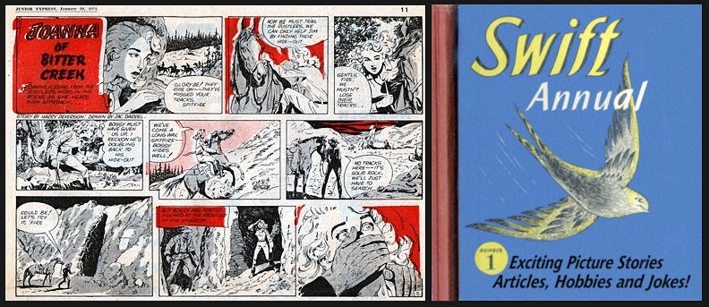
Lampitt returned to commercial illustration and with help from Deverson’s wide range of contacts, found steady employment contributing cover art for various publications, including the patriotic John Bull magazine, 10the British edition of Reader’s Digest and the children’s educational magazine, Look and Learn. 11 He also contributed designs for Medici Cards, the Whitbread calendar; and illustrated The Story Of Lassie for the British tabloid comic Mickey Mouse Weekly, 12 published by Odhams Press. 13
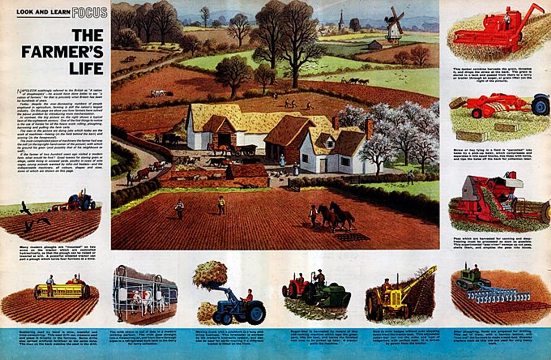
Twelve years after The Map That Came To Life appeared, the pair again combined their talents to create a variety of children’s titles. These included the historical storybooks Mainly For Children (1960-1962, published by The Sunday Times), The Open Road (1962, a follow-up to The Map That Came To Life) and The Story of Bread (1964), published in partnership with the industrial giant, Rank Hovis McDougall. The latter half of the ’60s and early 1970s saw Lampitt creating both cover art and illustrations for titles in the Ladybird 14 range of children’s books. Both the books and Lampitt’s Ladybird artworks are now highly valued by specialist collectors.
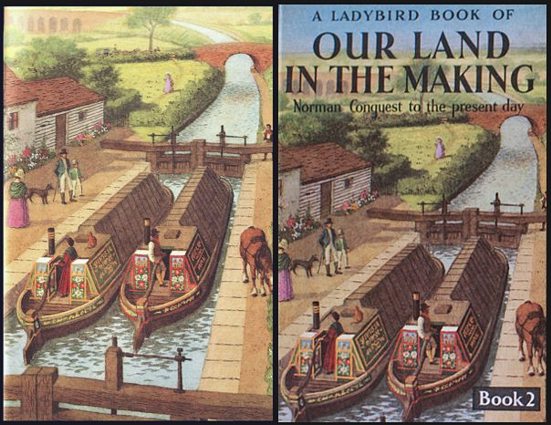
Sadly, Deverson died at the relatively young age of 63, on the 18th of September 1972. His obituary in The Times remembered him as ‘A warm and kind person, interested in everyone he met. He won the affection of all who knew him and he will be greatly missed.’ 15 Lampitt outlived his brother-in-law by some sixteen years, dying in October of 1988, at the age of 82; after a long struggle with Parkinson’s disease. A private, family man with a small but select circle of friends, he had never actively sought the limelight, so it’s ironic that Lampitt’s name has become the better known of the pair. Today, prints of Lampitt’s illustrations, railway posters and landscapes are available online, whereas Deverson’s name seems to have been relegated to little more than a footnote in the annals of British print media. However, the partnership of Deverson and Lampitt will forever be associated with educational children’s books, which encouraged generations of inquisitive young minds to explore their world with open eyes and a sense of adventure. Even if nothing else, that’s a fine legacy to leave.
Young Pioneers?
The period in which The Map That Came To Life appeared was one of austerity; a time of ‘Make Do And Mend’ 16 and supplementing still rationed food supplies 17 with home-grown produce. As for television, regular programmes had resumed in 1946, 18 but other than the Sunday afternoon Children’s Hour, 19 the BBC had little to offer young audiences. That small, flickering screen was yet to make any significant impact on those who, for the large part, still played outdoors and made their own entertainment. Deverson and Lampitt tapped into this vein of healthy, youthful exuberance by offering their readers an imaginative, immersive experience (John and Joanna’s day out), whilst subtly teaching a new skill. By following the story and, like John and Joanna, learning to relate the map’s legend to features in their own surrounding landscape, children gained a sense of empowerment from the practical and immediately applicable knowledge they acquired.
Interestingly, this empowerment of the youngster was recently commented upon, from a slightly different perspective, by a visitor to the diaphania blogspot. He had once used images from The Map That Came To Life to illustrate a talk about the visual narrative of post-war Britain.
A colleague at the time…was from Slovenia…once part of soft-communist Yugoslavia. When she saw these pictures of John and Joanna…she confirmed immediately my identification of them not as rural middle-class kids…but as Young Pioneers, striding with confidence and optimism into the future. Only the red neckerchiefs are missing. 20
We can only wonder what Deverson and Lampitt might have made of this interpretation – but if a simple, home-spun children’s story can manage to cross an ideological divide, then so much the better. If there’s one wish all loving parents have for their children, it must surely be to see them stride with confidence and optimism into the future.
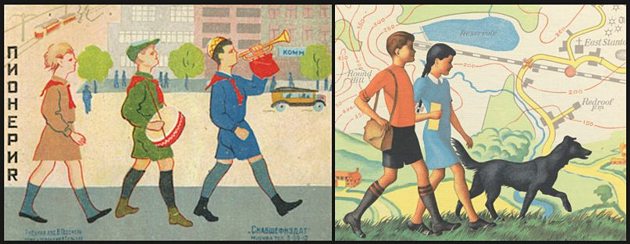
The Journey to Dumbleford
With a packed lunch made by Aunt Mary, our intrepid ‘Young Pioneers’, plus Rover, set off down the lane from Two Tree Farm, passing Pedro (Uncle George’s prized bull) and a field of turnips. The first feature they recognise from the map is the duck pond on the road to the hamlet of Blegdon, from where a signpost indicates the road to Dumbleford. John and Joanna choose the scenic route instead and climb over a stile to follow a public right of way that leads to Badger’s Common.
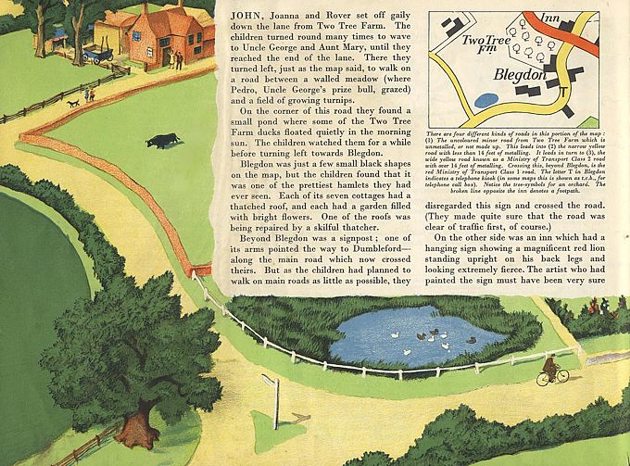
Shortly, they happen upon a gipsy encampment where bare-footed children play, smiling at John and Joanna as they pass by. John spots a small, yellow bird, which he misidentifies as a canary, but Joanna politely corrects him, identifying the bird as a yellowhammer – ‘one of the finch family, which looks quite like a canary at first glance.’ John adds the name to his notebook. The pair stop briefly to check the map again, then it’s on to their next port of call – the village of Greenleigh.

Here, the small, steepled church catches their attention and they meet the verger. Whilst Rover obediently waits outside, the verger conducts a guided tour, pointing out, amongst other historic features, a beautifully carved Jacobean pulpit and choir stalls. He also informs them that the village hall was once a tithe barn. ‘Tithe is an Anglo-Saxon word meaning a tenth part, and it was this proportion of his produce that a farmer made over towards the upkeep of the church,’ Deverson’s text explains. A brief visit to the village shop follows, for lemonade – and water for Rover – then onwards, pass the grandly appointed Greenleigh Manor and the war memorial, from where the map directs the trio towards a blacksmith’s forge and a derelict windmill.
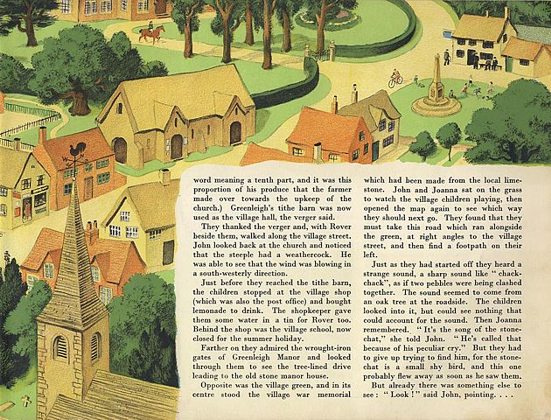
To the right of the windmill their path runs alongside a coppice of fir trees, where a cock pheasant scurries for cover at the children’s approach. A little further on and they come in sight of a narrow river. “Its name is Meander…But it’s not meandering now – it’s running quite fast!” jests Joanna. According to the map, there’s a ferry crossing – marked with an ‘F’ to indicate foot passengers only. As if by magic, the ferryman appears, pulling a flat-bottomed boat across the river by means of a thick wire passing through two looped, upright iron supports on one side of the boat. Once across the Meander, and having thanked the ferryman, John and Joanna check the map once more, then make their way to a nearby lake, where they enjoy Aunt Mary’s packed lunch. She’s even remembered to include Rover’s favourite biscuits.
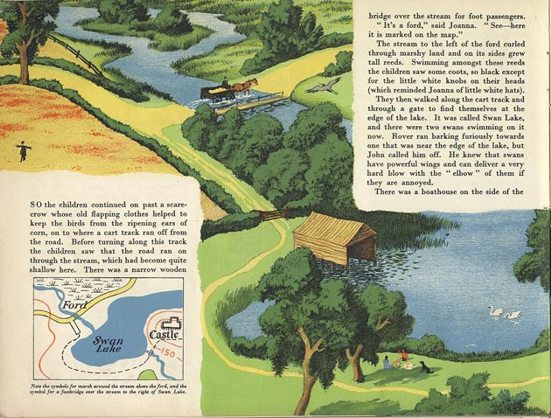
Although Lampitt’s map is an accurate, objective representation of the route John and Joanna take to Dumbleford, his accompanying illustrations are subjective, insofar as they portray a landscape untouched by the recent war. There are no remains of downed enemy aircraft in the fields and no abandoned defence installations hidden amongst the leafy lanes and hedgerows. Lampitt instead paints an idyllic vision of the British countryside, albeit one that is undoubtedly influenced in part by his own childhood. He uses vibrant colours and soft contours to create lush green meadows and marshlands, fields of golden haystacks and sky-blue lakes and rivers. This is a Britain that, in reality, never was – but it’s still rather beautiful in its innocence and simplicity.
Similarly, Deverson’s text ambles along at a gentle pace, exuding old world charm. Through John and Joanna’s interactions with those they meet along the way, Deverson subtly extols the virtues of working the land, politeness and respect for one’s elders, and the preservation of Britain’s cultural and historical heritage. Even the gipsies make camp without being hindered by draconian by-laws. Deverson also manages to weave a few history lessons into his narrative; and the references to Church architecture and bird-watching reflect Lampitt’s interests, foreshadowing his later artwork for Ladybird books.
The only dramatic event that threatens to spoil an otherwise perfect day is a fire in Dingle’s wood, which John bravely fights with a yew branch whilst Joanna fetches extra help to tackle the blaze. Afterwards, Tim, one of Mr Dingle’s farmhands, says the fire was probably caused by a carelessly discarded match. “I don’t hold with anyone lighting fires in woods at all…it’s far too dangerous.” As a reward for their quick thinking and resourcefulness, Mrs Dingle treats John and Joanna to a large bowl of loganberries and cream – these children are certainly well fed!

A little later and John and Joanna crest a hill, where they stop again – to enjoy the sight of a steam train racing across a viaduct. From there they descend into the valley, passing grazing sheep, a mill race and a reservoir that supplies the town of Dumbleford. After discovering two small, lost children and returning them to their parents, our intrepid trio pass through the village of East Stanton, where, close-by, they briefly investigate three Bronze Age tumuli.
Next, they come upon a ruined abbey, once a monastery and learn that the monks used to stock a nearby pond with fish, to provide themselves with food, and a little recreational fishing. Crossing a small, humped-back bridge, John and Joanna are suddenly startled by the roar of an aeroplane engine. To the left is Dumbleford Airfield and John is delighted to spot ‘the new De Havilland Dove…a Percival Proctor and an Auster.’ His bird-watching skills may be a little rusty, but the boy certainly knows his aircraft! Opposite the airfield a road to the right leads to Coldblow Common and as the children walk along it, in the distance they hear fairground music. Even Rover is excited!
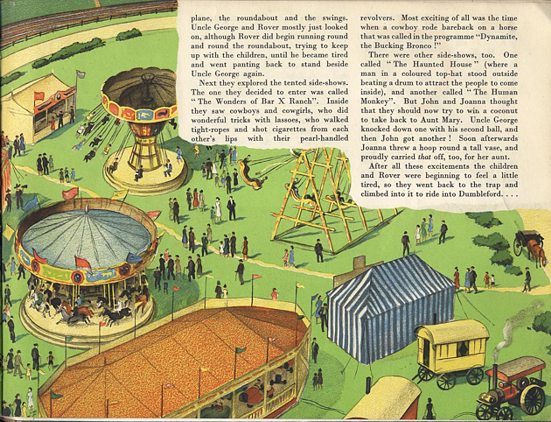
It’s been a long day for our young pioneers, but Uncle George is patiently waiting for them in his pony and trap on the far side of the fairground. On the return journey to Two Tree Farm (this time by road), John and Joanna relate all that’s happened to them – including the Dingle’s wood fire and rescuing the lost children of Hollyhill.
Uncle George turned and smiled at Joanna and said: “So now you really know what I mean when I talked about the map coming to life, don’t you?”
Joanna smiled back at him. “Yes,” she said. “And I hope we shall be able to make it come to life many more times during this holiday.”
“And so do I,” said John.
And so they did.
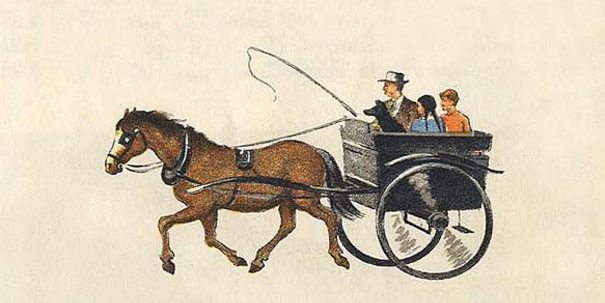
The Open Road
In the 1962 follow-up to The Map That Came To Life, John and Joanna are once again holidaying with their Aunt and Uncle. Lampitt’s illustrations have lost none of their charm, but now the adventurous day out includes Uncle George (fashionably nicknamed ‘Ug’ by his niece and nephew) and his shiny red, Hillman Minx motorcar. This time their destination is not a local fairground, but the seaside.
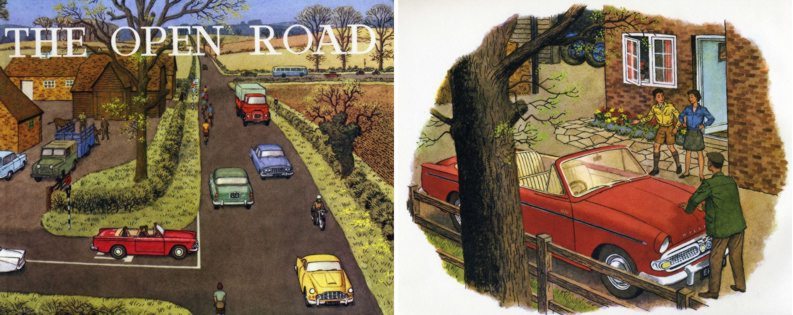
There’s no negative connotation to be drawn from the increased road traffic, busy towns and multi-storey car parks, or the recently opened M1 motorway. Indeed John and Joanna are ‘thrilled at their first sight of the broad, spacious carriageways with their three traffic lanes.’ This is a land in harmony with tarmac and concrete. There’s even a touch of product placement for the British motor industry. As Ug’s Minx passes a car-transporter loaded with brand new Minis, Deverson’s text reads: ‘Would they soon be bowling along the sweeping highways of North America or weaving their busy way under African skies…?’ How prophetic those words would soon prove to be.
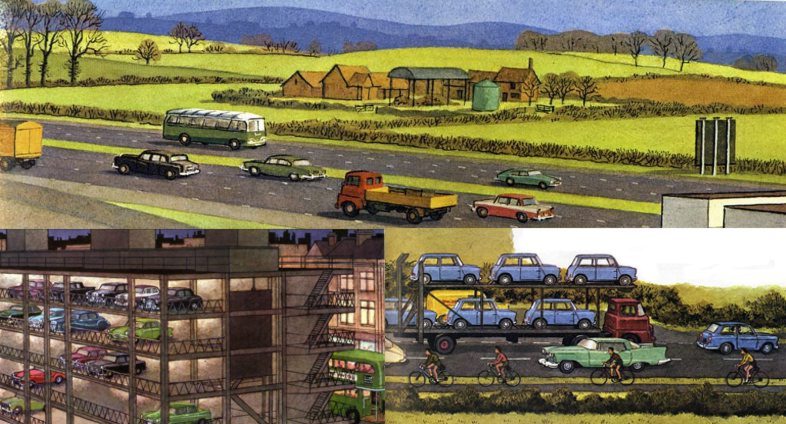
Putting aside the floating timeline (the teenage John and Joanna should be in their late 20s), Deverson and Lampitt strive to faithfully reproduce the rapidly changing landscape of 1960s Britain, although the story’s sub-plot is no longer about learning how to read a map. Instead it’s promoting the motor car as a means to explore beyond the limitations of a simple country walk. Whereas John and Joanna had previously taken the best part of a day to walk the four miles to Dumbleford fair – admittedly with a few breaks and some drama along the way – in The Open Road that same distance is covered in a matter of minutes by car. “There are nearly nine million motor vehicles of all kinds on the road,” Uncle George proudly tells John as they speed along the M1. The motor car is now King and the world is shrinking as the children grow. This is not intended as a criticism of The Open Road, merely an observation. Both books are of their time and should be viewed with this in mind. However, some of the innocence found in The Map That Came To Life has inevitably been lost in its follow-up, and the past has indeed become a different country.
The Story Comes Full Circle
As we grow and mature our tastes and interests change. We put away those childish things and, more often than not, forget them. Sometimes it takes decades to truly appreciate what we once had, but if we’re very lucky, those simple joys from childhood can be rediscovered and enjoyed once more.
Recently my, now old and battered, copy of The Map That Came To life came into my possession once more. Over the past forty-or-so years it had journeyed through the extended family, from one branch to another, until it was uncovered – quite by chance – by a cousin, at the bottom of a packing crate, under a heap of discarded toys. The dust cover had long since disappeared, the spine was broken and several pages were mottled, ripped and detached. The Map That Came To Life had clearly suffered under careless hands, so now it deserves to retire with dignity.
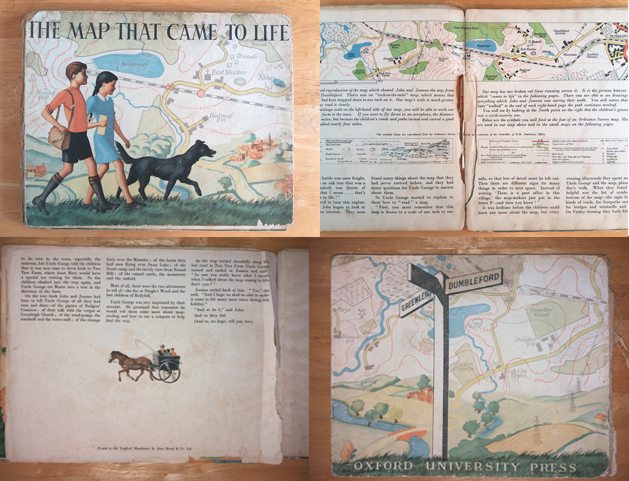
Whilst examining the damage, I was surprised to discover the book was a first edition. An internet search revealed that in 2018 a near-mint condition first edition had sold at auction for £900 (approx 1001 Euros or US$1127). Of course it’s doubtful that mine would reach even a ‘tithe’ of that amount on the open market, but the true value of a cherished childhood memory can never be measured by mere money. The touch and smell of those old, crackling pages transported me back in time – to a tousle-haired boy in shorts, with freckles, muddy knees and a penchant for climbing trees. The Map That Came To Life had to be saved.
The cost of a full restoration is presently beyond my means. So the book has been carefully wrapped and stored, well away from light and the elements, and, in the meantime, an alternative plan has been hatched. With very generous help from The Visual Telling of Stories website, 21 good quality scans of a 1954 edition have been obtained. They’ll require a little digital clean-up to remove a few marks and tidy the edges, but once printed and bound, a facsimile of the original will join the many other treasured books on my shelves. I’m tempted to title it: The Map That Came Back To Life.
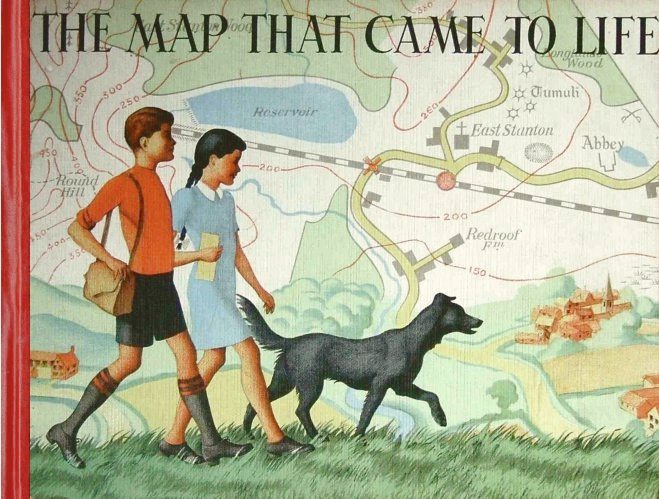
Works Cited
- Ordnance Survey (OS) is the official UK Map-making agency. See: https://ordnancesurvey.co.uk ↩
- http://www.lacrossehistory.org/literature/cached/AlltheBest.pdf ↩
- Ibid. ↩
- Deverson, Jane. Generation X. https://www.bbc.co.uk/news/magazine-26339959 ↩
- Deverson, Harry. Talking About Photographers: Bert Hardy. Camera World. Second article. Two installments: October (Pages 184-187) and November (Pages 222-224) 1956. ↩
- https://en.wikipedia.org/wiki/Antony_Armstrong-Jones,_1st_Earl_of_Snowdon ↩
- https://ladybirdflyawayhome.com/ronald-lampitt/ Also see: https://bearalley.blogspot.com/2010/02/ronald-lampitt.html ↩
- BLIMEY! The Blog of British Comics. Junior Express. http://lewstringer.blogspot.com/2015/06/junior-express.html ↩
- http://comiczine-fa.com/features/the-best-of-british-swift ↩
- https://en.wikipedia.org/wiki/John_Bull_(magazine) ↩
- https://www.lookandlearn.com/history/Look-and-Learn-History.pdf ↩
- International Companion Encyclopaedia of Children’s Literature. Routledge. p. 245. ISBN 978-1-134-87993-9. ↩
- http://www.history-pieces.co.uk/Docs/Odhams.pdf ↩
- https://www.vintageladybird.com/ See also:http://www.ladybird-books.com/ ↩
- The Times. Obituaries. 21st September 1972. No direct URL link available. ↩
- https://www.iwm.org.uk/history/8-facts-about-clothes-rationing-in-britain-during-the-second-world-war ↩
- https://www.iwm.org.uk/history/what-you-need-to-know-about-rationing-in-the-second-world-war. Also see: https://www.youtube.com/watch?v=o9wNJ78S2GY ↩
- https://www.bbc.co.uk/historyofthebbc/birth-of-tv/resurrection-1946 ↩
- https://www.bbc.co.uk/historyofthebbc/research/programming/children-and-the-bbc ↩
- http://diaphania.blogspirit.com/archive/2008/10/09/lampitt-s-living-maps.html See comment made by Paul Stiff. 3rd of November 2008. ↩
- http://www.fulltable.com/vts/aoi/l/lampitt/map.htm ↩
What do you think? Leave a comment.











Amyus this is terrific!
I think the book (it’s one of my all time favourites) should be reprinted immediately in facsimile. Cheers for reminding me about it.
It also brought to mind another beautifully enriching book from my childhood called ‘A Valley Grows Up’. It shows, through a series of superb paintings by Edward Osmond, the same bend of a river going around a hill- from prehistoric times to 1953.
Mila. Thank you so much. I’m delighted you remember ‘The Map That Came To Life’
I’d love to see it reprinted, but alas I think that other than those who loved the original, there would be only a small, specialist market for the book. That’s why I am in the process of recreating a facsimile of the 1954 edition, for my own enjoyment.
Sadly we live in an era of online maps and ‘apps’ so few these days have the patience to learn how to read a traditional map.
Thanks for your recollection of ‘A Valley Grows Up’ – that was another of my childhood favourites. Osmond’s paintings are quite suberb, I completely agree.
I didn’t look at ‘The Valley Grows Up’ before making that last comment. In fact Osmond’s pictures stretch from a phenomenal 5000BC to 1900. And ‘The Map that Came to Life’is advertised on the back flap.
Thanks again for such a cool article.
I’m curious to know how much you paid for your copy, as I’d like to get a copy. There seem to be few available secondhand.
Corrine. I’m not sure how much it originally cost as my copy (the 1948 first edition) was given to me by my mother, who had received it as a child, when, presumably, it was new. I have seen a few copies of later editions for sale online and the price varies considerably depending on the condition. You may (and I stress ‘may’) be able to find a copy for under £100, but you’ll need to hunt down specialist collectors. Sorry I can’t be any further help at the moment.
I paid exactly £1 for my copy, which is in reasonable condition but is not a first edition. So there are bargains to be had if you’re lucky.
Hathaway. Wow, that’s some bargain. You were very lucky. Check what year it was printed, you may find you have something special. 🙂
Great book. The maps are portrayed as objective, precise and above all truthful mirror of nature.
Quickie. I agree. The illustrations are quite simplistic, but I particularly loved Lampitt’s attention to detail. I remember, as a child, quite literally tracing the journey across the maps and, like John and Joanna, learning the legend. It was a good lesson and one I never forgot.
It’s interesting how far an old children’s book can take you.
Grayce. Indeed! The older I become the more I rediscover things from my childhood and can appreciate them better.
It’s brilliant in its nostalgia, and in its charting an England that never really existed.
Dorian. Even for the time in which it was published, there was a touch of nostalgia to the book. You’re quite right though, the England portrayed is close to being a magical reality. Sadly, I don’t think such a book could be published today.
Ambient read. My favorite books that teach children about maps are The map that came to life, Here we are, Junior Atlas of Alberta and Looking at maps.
mailer. Thanks for the feedback. It’s great that you have your favourites as well. I think it’s a shame that map reading isn’t taught to children these days. Even if nothing else, it would give a child a sense of achievement and boost self-confidence.
Amyus! Love how the article turned out. These kinds of books are so treasured and special, and still such a great teaching tool with kids. I’m wracking my brain trying to think of an American equivalent, but all I’m coming up with is Dora the Explorer…which is not a flattering comparison (lol). Looking forward to your next article!
Hi Eden. Thanks for the praise and the interesting chat during the editing stage. I’m not that familiar with American children’s books, but, you never know, maybe there’s a long forgotten gem yet to be rediscovered. 🙂
Maps have always been fascinating to me. I’m not sure what held my imagination as a child, perhaps that I have always seen maps as an effective means of time travel or that my grandparents owned a farm in rural Sussex and I too walked across the fields to the village.
Mel. Thanks for the response. I like your comment about maps as an effective means of time travel. That’s exactly how I felt when I got the book back. Maps really do encapsulate a moment in time. I’m pleased this brought back some fond memories for you.
There is a beauty and simplicity in this one.
melfis. That’s really kind of you. Your succinct comment captures exactly what I was trying to achieve with this article. Thank you very much.
In the same spirit (but no colour pictures) is a much loved Puffin “South Country Secrets”, in which the children stick a pin in a map and then set out to explore that place (all in the south of England). By Barbara Euphan Todd and her husband “Klaxon” in 1947.
Filomena. I’ve never come across ‘South Country Secrets’ so I’ll have to keep an eye out for that. I really like that idea of just sticking a pin in a map then setting off to see what’s there. It sounds very adventurous. I’m sorry to say the only works I know of by Euphan Todd are the Worzel Gummidge books. Now that takes me back!
Rather perversely, I had to read this book as a punishment (for spilling ink) as an eight year old… and it opened my eyes to the delights of OS maps and cartography in general! I have a reasonably extensive collection of maps (always buy two, one to use and one to keep) and my son is now a lead surveyor, having become truly aware at the same age as I did.
I need the original book, the scans are ok, but the book would complete my collection.
Earlie. What a delightful tale! Excuse me, but I had to have a chuckle at that. What a wonderful image it conjures up. Still, as you said, it opened your eyes to OS maps and cartography. I, like you, have collected numerous maps over the years (though only one of each) and I still prefer a decent paper map to an app or GPS. Nice to see your passion has been taken up by your son.
Re the original book, it’s tough to find. Occasionally one might appear in a specialist auction, but they always fetch a high price. Sorry I can’t help you further with that. I consider myself very lucky to have my original book once again, even if it is in a sorry condition. I’ll never part with it again.
I love the things this stands for, gentler, simpler times.
Roseann. Too true. I’ll admit to a touch of sentimentality, but at least you could still drink from streams back then and I’m convinced summers lasted forever! 🙂
Great article, accompanied by beautiful images, about what is surely a lost fictional treasure.
Thanks Stephanie, that’s really nice of you. Our childhood treasures really deserve to be saved. I just wish I’d managed to reacquire the book before it became so damaged.
I have an original 1948 edition of ‘The Map That Came To Life’.
The later edition had replaced the steam railway engine with a diesel locomotive. Unfortunately my copy is in somewhat poor condition now, having been mangled by a young relative. It wasn’t really her fault, she was too young to realise its value. I’ve recently managed to find some decent hi-res scans on the internet and I’m planning to make a new book with these scans.
Anyway, thanks for the memories.
Mary. Wow, I’m delighted to find someone else with the original 1948 edition! Small world, hey? I hope yours in in better condition than mine.
Yes, I do remember seeing a later edition (1963 or 1964) in which the steam train had been replaced with a diesel locomotive. My memory seems to think it was blue, but I may be incorrect. I searched high and low around the internet to find an image of the diesel, but alas – nothing! I believe whomever had updated the images (I doubt it was Lampitt) had also restyled the vehicles and clothing. Perhaps it was an attempt to cash-in on the release of ‘The Open Road.’
‘Unfortunately my copy is in somewhat poor condition now, having been mangled by a young relative. It wasn’t really her fault, she was too young to realise its value.’ You’ve taken the words right out of my mouth as that’s exactly what happened to mine. I was trying to be discreet with my writing as I didn’t want to publicly shame my relative, just in case she read the article. I wonder, where did you find your scans? The Visual Telling of Stories website, by chance? It seems that site is no longer live, so I’m pleased I managed to get the scans I’m using to remake the book in time.
Thank you for your response. It’s great to connect to another like mind. I hope your new book turns out well. 🙂
A brief addendum. The URL link I gave for The Visual Telling of Stories website had a small error. It’s now fixed and I can confirm that VTS is indeed still alive and kicking. It’s a great resource.
Just been writing about this book. Will reference your awesome article on it.
Guinn. Thank you, that’s very generous of you. I’d be very interested to read your article when it’s finished. BTW, if there’s anything I can help you with, in terms of research, then please feel free to PM me. I’ll be happy to pass on images, info etc.
About Maps. Puffin Picturebook. Great book. It was tattered and second hand when my Dad gave it to me. It, along with The Map That Came to Life, sparked my lifelong interest in maps as virtual travel and time travel.
Kemp. Yes, I remember ‘About Maps’ by Peter Hood (1961). Sounds like your copy has a story of its own. It obviously meant a lot to your Dad, for him to then pass it on to you. Somehow I can’t quite see the same thing happening with ‘apps’. Where’s the history and romance in a piece of coding? Give me a paper map any day of the week! Maps as virtual travel and time travel – I like that. Spot on.
Got The Map that Came to Life at primary school. So began a love of maps.
Michiko. Brilliant! It’s great to think how a book can inspire so many people and awaken a child’s interest in his or her surroundings. Once you gain the ability to read a map, it stays with you for life. I just can’t get excited about apps in the same way.
Great coverage of this book. I have stronger nostalgia for The Open Road.
zoom. Yes, I too had ‘The Open Road’ as a child. A great book. I’m pleased I’ve brought back some memories for you. Thanks for the compliment re the article. Greatly appreciated.
I absolutely loved this book as a child! Thanks for posting.
Meg. You’re welcome. I never realised so many at the Artifice were even aware of the book. The response has been surprising and delightful. I’m really pleased you enjoyed The Map That Came To life. Its kind will probably never been seen again.
There is something so wonderful about escaping in to a story book land where tigers who come to tea are not the slightest bit threatening or everyone just comes together and builds a house for their neighbours.
Ute. Oh, naughty, naughty – I know where you got that passage from 🙂 Ssh, I won’t tell 😉 Anyway, thanks for the response.
John and Joanna. Who can forget.
Watt. Who indeed! Thanks for the comment. Much appreciated.
Ronald Lampitt had a strong affection for maps and how they work in our minds!
Loveless. He certainly did. During my research I came across a rumour that he’d also helped to create some of the maps for the D-Day landings, but didn’t include that as I couldn’t authenticate it. I would have liked to have explored Lampitt’s work in more detail, but my focus was on The Map That Came To life. His map making skills and his draughtsmanship were superb. He aroused my interest and even to this day I still occasionally doodle small maps just for fun, inventing non-existent landscapes. Thank you for your contribution.
Just lovely.
Minor. Thank you. Very kind of you 🙂
The Map That Came to Life. I haven’t seen anyone mention that book for ages. It was one of my favourites as a child and I still have the book now. It was feeling pretty dated when I was a child but I loved it.
burkham. Thanks for the comments. I seem to have stirred up quite a few memories with this article. I really didn’t imagine it would have that much of an impact. It’s great that you still have a copy of The Map That Came To Life. I hope it’s in better condition that mine. Yes, it was dated when I was a child, but, like you, I loved it all the same.
Similarly to the book, in Kyoto, Japan the Kamogawa River came to life as my partner and I walked along it.
Bianca. How romantic. Sounds like there’s a story to be told! Alas, I haven’t (yet) visited Japan, but it’s on my bucket list. I’ve always wanted to visit the north of Japan, especially around the Kushiro wetlands. Thanks for your comments. My best to you and your partner.
Now I desperately want a copy of The Map That Came to Life!
Hedy. Hathaway (see comments above) managed to find a copy for a mere £1, so you never know, maybe somewhere out there, in a second hand book shop or a car boot sale there’s a copy with you name on it! Good luck.
This book can be used as a tool for exploring modern day maps.
Mendy. Well, maybe the book is a little out of date now, but the idea behind it is just as applicable today. A modern-day digital version could even be interactive. Now there’s a project for someone to take on!
A masterpiece on power of good map design.
Caprice. I couldn’t agree with you more. Thanks for your comment. 🙂
It helped take me out into nature and explore it as a child.
grayor. Me too, suddenly you start to see the world around you with new eyes – just as Deverson and Lampitt intended. Thanks for your memory and thanks for reading.
aquableu. Thank you. I’m pleased you enjoyed the article.
I’m so glad to see this published. This is such a well-written article, and you should be proud of all of your hard work. Thank you for sharing this with us!
M.L.Flood. Thanks. I never thought I’d stir up so much nostalgia. It’s been a pleasant surprise.
Really great article, thank you.
Keaton. Thank you for your comment and you’re very welcome.
Thanks for sharing a beautiful childhood memory, I think we can all read this and immediately think of a handful of texts that still call a smile to our faces today.
SaraiMW. Thank you for reading and your kind comments. Very much appreciated 🙂
A very good essay on a book I knew nothing about.
Joseph Cernik. Thank you. It’s amazing what can be rediscovered lurking at the bottom of old packing crates. 🙂
Great article. It is definitely quite nostalgic to reminisce.
stephaniehamilton. It certainly is. We all have precious memories from childhood and it’s so important to preserve them. This book really encapsulates my childhood, that’s why I’m delighted it was returned to me.
Sounds like a delightful book I would have enjoyed as a child, perhaps now too. I loved maps of all kinds from when I was quite young. By the age of six I was the accepted navigator on family road trips. I wonder if our growing dependence upon online map apps is eroding our ability to read, understand, and even make maps of our own?
pgherron. Thanks for your response, and your memory of being the family navigator at the age of six gave me a chuckle. Wonderful! I completely agree with you re apps. As someone who grew up able to read a REAL map at a glance, I have to remind myself that to youngsters nowadays trying to read a paper map must be akin to trying to learn a new language. If you follow the very last link I gave in the works cited section then you can see all the pages from The Map That Came To Life and follow the story for yourself. Thanks again for your comments. 🙂
After having been a caregiver to several children on the cusp of teenagehood, I appreciate children’s stories like this one that help us reclaim the whimsicality through which we used to see the world. I found the scans of the pages and pictures from this book online and spent some time admiring them. While it’s an instructive children’s story, yes, it also has just enough elevated language and drama to keep the interest of adults, too. It makes me think that adults can sometimes appreciate a return to the wonder-filled eyes with which we used to observe the world!
rachelwitzig. Thanks for your reply. You’ve really tuned into how I felt upon recovering my treasure. It’s fascinating how just the smell of something can instantly awaken memories. I’m pleased you found the scans of the pages and enjoyed reading them and I agree with your assessment of the book. Sadly, I doubt we’ll ever see anything like it being produced today.
See The Characters Dance And Sing By Minister Cardinal General
Sir Troy Anthony Platt
Reference: 4822102019
Tuesday, 22 October 2019 4.00PM to 20:21:28
When children grow up,
They read many books.
Some of them become treasured memories,
A childhood book can shape our lives.
Stories, pictures, sounds, and the narrative,
Helps us to discover our imagination.
Even we can image the scene of the characters.
For me I like dancers of a musical.
See the characters dance and sing.
For I shall write this magical tale.
From this Kingdom of Bellaawood,
Comes this tale of a map.
Every child dreams of adventure,
This story is for you.
Let me tell you about the story.
It is unique to me as I dream.
Wonder after wonder,
A tale of great fun,
So journey with me, this storyteller,
Is waiting for you.
The treasure of reading is very exciting.
Therefore, I begin with this song and dance.
© 2019 COPYRIGHT TROY ANTHONY PLATT,
G.P.O. BOX 340 BELLAAWOOD CFI-007,
BALLARAT, VICTORIA, AUSTRALIA 3350
Thanks for your reply. I hope your book sells well.
I loved exploring The Map That Came to Life through your article which was especially enlightening as I had never heard of it before. From what you revealed it looks to be a beautiful book. I had admired Lampitt’s illustrations in some Ladybird books I’d acquired in a second-hand bookshop years ago, so it was wonderful to find out more about him. Thank you.
Jen. Thank you for your comments. I grew up reading Ladybird books and I also admired Lampitt’s work. I’d imagine stepping into the worlds he created and exploring the towns, cities and countryside vistas. A child’s imagination knows no bounds. I’m pleased you enjoyed the article. It really has been a surprise to me just how many people here at the Artifice remember reading The Map That Came To Life, but it’s also very pleasing to introduce someone new to the book and its follow up. Hold on to those old Ladybird books, early editions can be quite valuable now. Thank you again.
What a great article about two lives reaching further than “The Map That Came to Life” ever could. Lampitt’s decision to forego his dad’s advice of getting “a real job” and pursuing his passions is so inspiring. I long for a life of respect and simplicity that can be experienced through the eyes of these two young characters, John and Joanna.
bjsuri. Thank you for your kind comments. I think there are many like Lampitt whose passion can’t be restrained. From my research I learned that his father had worked for the railways, so even if Ronald had got that ‘proper job,’ (presumably alongside his father) I can imagine he would have inevitably ended up sketching and painting pictures of railway locomotives. Admittedly ‘The Map That Came To Life’ does tend to view the countryside with rose-tinted spectacles, but even so it’s always been a favourite of mine. I too long for a life of respect and simplicity. Sometimes this modern world can be a little too much!
Here is a large collection of Ronald Lampitt’s work:
https://www.flickr.com/search/?user_id=55421523%40N08&view_all=1&text=LAMPITT
DAVID WILSON. Thank you. I was already aware of that collection at flickr. Still, it’s nice to come across someone else who appreciates Lampitt’s work.
Discovered this very interesting post while trying to find out about the book, which was one my father had as a child and which I remember reading. Possibly it was responsible for my love of maps, exploring and orienteering and now geocaching.
Mike Bailey. Thanks for your comment. I’ve really enjoyed reading comments from those like you who have been inspired by reading The Map That Came To Life. Whatever sparks a child’s imagination is worth revisiting as an adult. At times such as this, we should all be outside, getting as much fresh air andf sunlight as possible.
It is always a treasure to know what depth a book has!
I’m one of the 1950’s kids who was fascinated by, and loved this book and it’s sequel. (And am horrified by the prices listed for it on the net! Bang goes a dream, and it must remain a fond memory.) The cover picture is so memorable – seeing it again here brings back the ten year old I once was. As you say, a different, long gone and mildly idealised world, but none the worse for that. Do they still make good, useful and gently educational books like this today? And, yes, having introduced me to ‘old friends who take you to wonderful places’, as the man who drew the OS cover art once said, I grew up loving maps, still do, and use them regularly on my walks. Those two gentlemen left us a great legacy, didn’t they?
John Davies. Thanks for your comments and my apologies for the tardiness of my reply. Yes, Deverson and Lampitt certainly left a wonderful legacy, something that just can’t be captured with an ‘app.’ You ask, ‘Do they still make good, useful and gently educational books like this today?.’ Good question and to be honest, I haven’t looked too deply into that aspect, but I do worry about the level of political correctness and ‘wokeness’ that seems to be invading educational entertainment for children in general. Where’s the sense of adventure and discovery we once had? Recently I’ve been looking at the old I-Spy children’s books again – yet another collectible series – and realised we, as children, had a great deal more freedom to explore and discover for ourselves. I’m pleased to read that you’re still using paper maps. You can never be out of reception range with a decent map. 🙂